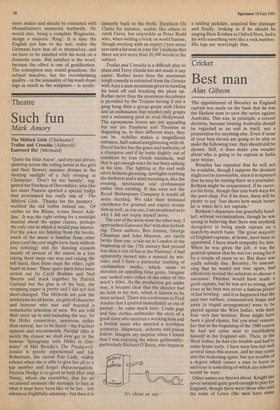Art
Satisfied
John McEwen
Michael Sandle's debut at Fischer Fine Art (till 7 August) proves the event of the artistic season as far as the private galleries are concerned. On the evidence of these latest drawings and bronzes there is no more richly metaphorical and sensual an imagination at work in English art today, and the gallery does him proud with the best installation, particularly downstairs, that they have ever put together.
Sandle has a big underground reputation in England as a romantic outsider, based largely on one or two spectacular contributions to public shows and encouraged by a long exile abroad. But this does not mean that his work is difficult to understand. On the contrary, it is his willingness to tackle emotional, archetypical, subjects with both Victorian dash and attention to representational detail that most differentiates his art from the formal nit-picking that has been the overriding concern of so many of his contemporaries. Artists have tended to avoid the moral dilemmas of our time but Sandle is a shining exception to this general rule. Historical and public themes are explored in terms of his own psychological obsessions. This latest work, for instance, can be most readily understood as a series of proposals for public monuments on the subject of war — especially the last war — and private tombs.
But the encompassing theme is obviously death with a capital D, and within that general context the metaphorical rings run ever closer and more specific to the artist's own experience. One of the most spectacular models for a public monument, grandly entitled 'Second World War Memorial', shows a crashed Lancaster bomber held suspended between the partially destroyed walls of a German bunker. It is a memorable image of frustrated power, contrived for the most part to a notable degree by some subtle derivations from the norm in the modelling of the aircraft itself. The wings remain impossibly intact, gun turret and engines are threateningly enlarged. Discs jutting out like plates from the side of the plane signify billows of smoke. They are also a formal device for casting shadows. Elsewhere in the exhibition Sandie wedges them into the bases of his catafalques for the same dramatic, incidental, purpose. They owe something of their origin to his constructivist training as an artist — the use of pure form — and even more, perhaps, to his delight as a boy in the shapes of the fungi that grow on tree trunks. But most of all they demonstrate his imaginative freedom, the advantage the modern artist has in a post-Cubist world. The modern artist can use everything at his disposal, his predeces sors had to do what they could within a recognised representational convention.
Downstairs at Fischer the space is given over to nine small table-top bronzes, a mixture of suggestions for public memorials and private tombs using variations on a single base and often the same shrouded figure of a decomposing corpse. The corpse is laid in turn on a bridge, a sledge, a raft, a ship of death, and these symbols of passage, coupled with the corruption of the flesh, classify this body of work as a modern equivalent of gothic transi — mediaeval cadaver tombs calling our attention to the transitoriness of worldly things. Each sculpture is spotlit on its stand, giving the gallery the spectral atmosphere of a moonlit crypt. Perhaps the most beautiful of these pieces is positioned at the foot of the stairs, an empty base patinated with copper nitrate purposely to evoke the shallow-sea green of Chinese bronzes. This beautifully ledged base derives from the work of Sir Alfred Gilbert of 'Eros' fame. The eclipse of Gilbert's reputation as a sculptor coincided with a marked decline in the standard of English public sculpture in general. Now that his reputation is on the wax again perhaps public commissions will also be conferred with more discrimination. At present they consist largely of softly pornographic girls and dolphins, with the odd abstract fol-de-rol thrown in to placate the highbrows.
Sandle would be a magnificent monu ment maker and should be entrusted with Mountbatten's memorial forthwith. He would also, being a complete Wagnerian, design a majestic 'Ring'. It is time the English put him to the test; today the Germans have him all to themselves, and we have to be satisfied with his work on a domestic scale. But satisfied is the word, because the effect is one of gratification. The conception may sound grandiose, the subject macabre, but the overwhelming quality — in the sensuality of his wash drawings as much as the sculpture — is erotic.



































 Previous page
Previous page